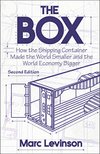The Box: How the Shipping Container Made the World Smaller and the World Economy Bigger - Second Edition with a new chapter by the author
amazon.com
The Box: How the Shipping Container Made the World Smaller and the World Economy Bigger - Second Edition with a new chapter by the author

One fact above all had traditionally defined life along the waterfront: employment was highly irregular. One day, the urgent need to unload perishable cargo could create jobs for all comers. The next day, there might be no work at all. A port needed a big labor supply to handle the peaks, but on an average day the demand for workers was much
... See moreExperimentation began anew after the war. Amphibious landing ships were recycled as “roll on–roll off” vessels to transport trucks along the coast, improving on techniques originally developed to land troops and tanks in over-the-beach invasions.
Harsh working conditions, economic uncertainty, and the insularity of docker life gave rise to unique mores. Dockworkers saw themselves as tough, independent men doing a very tough job. William Pilcher, studying longshoremen while working as one, found that his colleagues cherished and cultivated reputations as drinkers and brawlers.
The Box, I hope, has contributed to public understanding that inadequate port, road, and rail infrastructure can cause economic harm by raising the cost of moving freight.
What both transportation companies and shippers were slowly coming to grasp was that simply carrying ocean freight in big metal boxes was not a viable business. Yes, it produced some savings: cranes, boxes, chassis, and containerships eliminated much of the cost of loading and unloading vessels at the dock. Shippers, however, cared not about
... See moreAsked later whether he had considered ways to shelter some of his wealth from the risks of entering the maritime business, his answer was an unequivocal “No.” McLean explained: “You’ve got to be totally committed.”
The economic benefits arise not from innovation itself, but from the entrepreneurs who eventually discover ways to put innovations to practical use—and most critically, as economists Erik Brynjolfsson and Lorin M. Hitt have pointed out, from the organizational changes through which businesses reshape themselves to take advantage of the new
... See moreMalcom McLean’s genius was acknowledged unanimously: almost everyone save the dockworkers’ unions thought that putting freight into containers was a brilliant concept. The idea that the container would cause a revolution in shipping, though, seemed more than a little far-fetched. At best, the container was expected to help ships recover a tiny
... See moreMalcom McLean sold his stock and quietly left the board of R. J. Reynolds Industries in February 1977. By all accounts, the marriage had not been a happy one. McLean was frustrated by the tobacco giant’s bureaucracy and bewildered by its repeated changes of strategy. Most of all, though, he was restless. “I am a builder, and they are runners,”
... See more